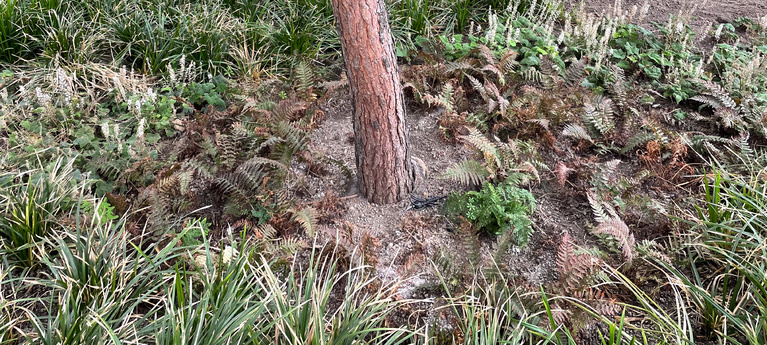A planting hole should be dug carefully. The space which the tree gets in the planting hole is not the same as the space taken up by the root system. In addition, soil improvement is often necessary before trees are planted in urban areas. This can be done by turning over the soil, preparing the planting location with tree sand or tree gravel, or improving it with fungal dominated humus compost.
Planting-hole preparation and soil improvement
Space for root development
The space the tree gets in the planting hole is not the final space the root system will fill. The final space for root development is of course much larger. This must be taken into account during development of the plan. This space can generally be calculated using the following rule of thumb: space available for root development = 0.75 to 1 m³ per square metre of crown surface area. A tree taller than 15 metres will grow around a square metre per year in crown surface area, so an extra cubic metre of topsoil or tree soil will be needed each year for the root development. When setting up the growing location, it is therefore also crucial to factor in the lifespan of the tree. A horse chestnut, for example, can grow to be eighty years old in its growing location. This tree will therefore require eighty cubic metres of space for root development. An ornamental cherry tree between six and ten metres tall will only grow to be thirty years old, will not have such a large crown surface area and therefore only requires fifteen cubic metres of space for root development.
Soil improvement
Urban environments often don't have the best soil in which to plant trees. The soil can be compacted by construction and it may also contain too few nutrients due to an increased (building) sand content. Depending on the soil at the location and the function of the area, there are various ways to improve the soil.
Compacted soil
In some cases, the soil around a planting hole may be compacted, which means that the soil has been pushed down by pressure. A mixture of different soil types can increase compacting. The roots of a tree cannot penetrate compacted soil as there is no oxygen present. This creates a 'flower-pot effect', the roots can only find oxygen and nutrients within the planting hole itself. This can continue to cause disappointing results years after planting and even result in the death of the tree. If the planting location and surrounding area are found to be highly compacted during planting, the soil will need to be loosened by being turned over using a crane digger.
Preparation of the planting location with tree sand or tree gravel
This method for preparation of the planting location is often used for trees planted in paving, as tree sand also forms a good foundation for streets. Tree sand is made up of sand mixed with organic material. It's not an optimum growing medium but rather a compromise mixture, which combines the requirements a tree makes of the soil with civil-engineering requirements in connection with subsidence. Tree sand can be used under cycle paths and footpaths. If further compacting occurs, under parking areas and streets with low driving speeds, for example, tree gravel is a better option. This material consists of volcanic lava, has sufficient nutritional value for the tree and can bear the load of cars. When tree sand and tree gravel are used, the volume should be at least one and a half times the space calculated for root development in topsoil.
Improvement with fungal-dominated humus compost
Forests are an optimum location for trees. The forest soil contains a high humus content and a complex variety of soil life, including many micro-organisms, such as fungi. Soil improvement using fungi-dominated humus compost recreates the optimal location for trees as closely as possible and enriches the biological soil activity, which eventually ensures that nutrients are made available for the tree. A maximum of ten percent humus compost can be mixed with poor soil to create a good growing medium.









